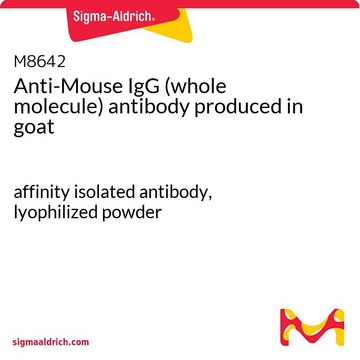Kluczowe dokumenty
76085
Anti-Mouse IgG - Atto 594 antibody produced in goat
~1 mg/mL protein, affinity isolated antibody
Synonim(y):
Atto 594 - goat-Anti-mouse IgG
About This Item
Polecane produkty
pochodzenie biologiczne
goat
Poziom jakości
białko sprzężone
Atto 594 conjugate
forma przeciwciała
affinity isolated antibody
rodzaj przeciwciała
secondary antibodies
klon
polyclonal
zawiera
50% glycerol as stabilizer
reaktywność gatunkowa
mouse
stężenie
~1 mg/mL protein
fluorescencja
λex 603 nm; λem 625 nm in PBS
Warunki transportu
wet ice
temp. przechowywania
−20°C
docelowa modyfikacja potranslacyjna
unmodified
Powiązane kategorie
Opis ogólny
Affinity isolated antigen specific antibody is purified from goat anti-mouse IgG antiserum to remove essentially all goat serum proteins, including immunoglobulin. Goat anti-mouse IgG associates with mouse IgGs.
Immunogen
Zastosowanie
Komentarz do analizy
Informacje prawne
Oświadczenie o zrzeczeniu się odpowiedzialności
Nie możesz znaleźć właściwego produktu?
Wypróbuj nasz Narzędzie selektora produktów.
Kod klasy składowania
10 - Combustible liquids
Klasa zagrożenia wodnego (WGK)
WGK 1
Temperatura zapłonu (°F)
Not applicable
Temperatura zapłonu (°C)
Not applicable
Środki ochrony indywidualnej
Eyeshields, Gloves
Certyfikaty analizy (CoA)
Poszukaj Certyfikaty analizy (CoA), wpisując numer partii/serii produktów. Numery serii i partii można znaleźć na etykiecie produktu po słowach „seria” lub „partia”.
Masz już ten produkt?
Dokumenty związane z niedawno zakupionymi produktami zostały zamieszczone w Bibliotece dokumentów.
Klienci oglądali również te produkty
Produkty
Immunoblotting (Western blot transfer) is a common technique in modern proteomics research.
Nasz zespół naukowców ma doświadczenie we wszystkich obszarach badań, w tym w naukach przyrodniczych, materiałoznawstwie, syntezie chemicznej, chromatografii, analityce i wielu innych dziedzinach.
Skontaktuj się z zespołem ds. pomocy technicznej
